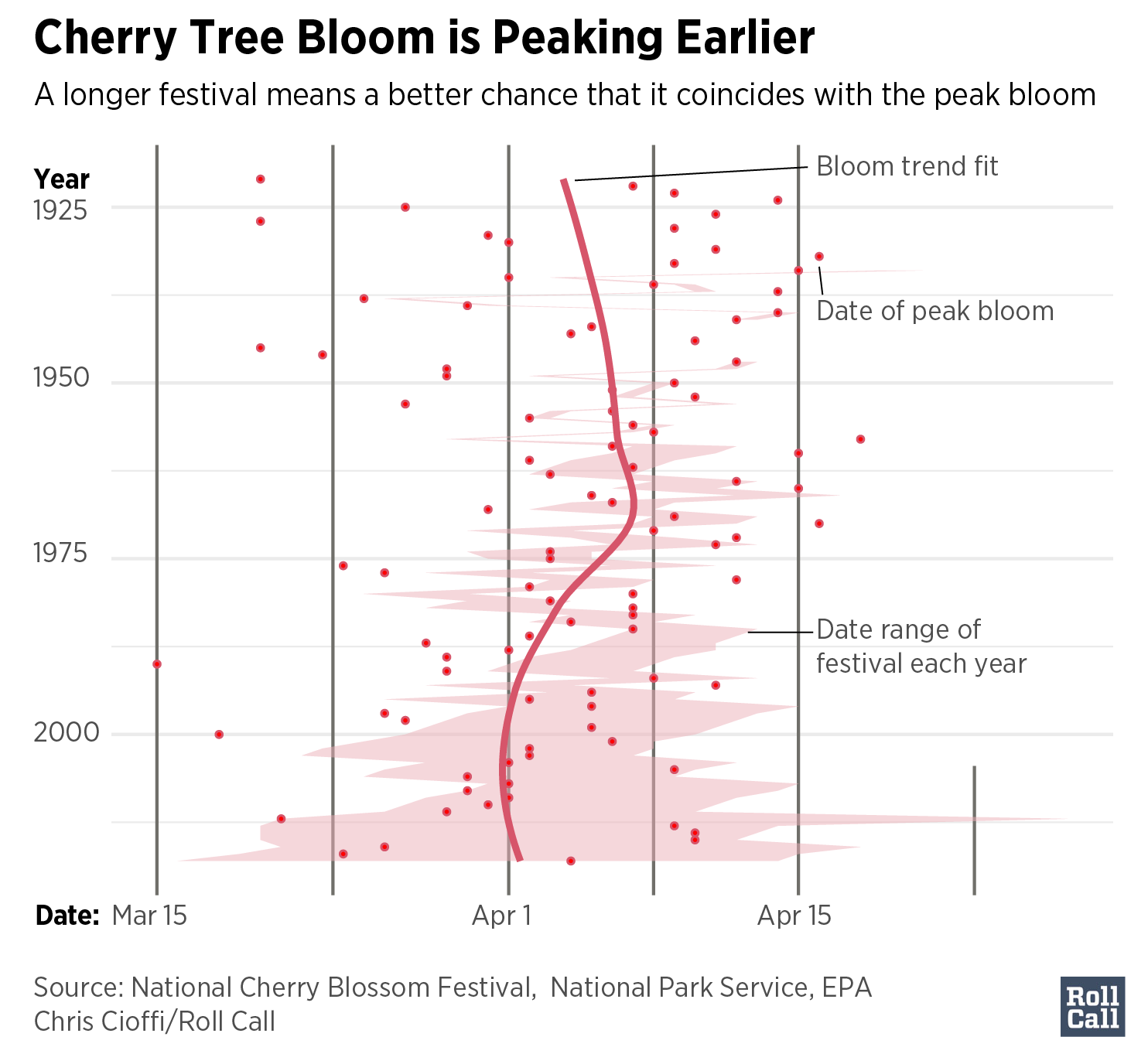Cherry blossoms in winter? Global warming could make it happen
Peak bloom — and cherry blossom gawking — coming earlier and earlier

Washington’s iconic white wreath of cherry trees surrounding the Tidal Basin has reached its fullest, following a trend of earlier and earlier blooms.
Despite some chilly days in March, the National Weather Service announced Monday that the trees were at peak bloom — meaning 70 percent of the Yoshino cherry trees were in blossom. Researchers found the average timing of peak bloom had shifted nearly a week since the trees were planted in 1912, and believe peak blooms could one day occur during the tail end of winter, not the beginning of spring.
It’s good timing for the National Cherry Blossom Festival, which began March 20 — the first day of spring — and will last through April 14. Those hoping to see this year’s fluffy blooms should have about seven to 10 days because of favorable weather.
The bloom timing is fortuitous, said Diana Mayhew, president of the festival. “I’m excited because it looks like we’re going to definitely get another weekend out of it,” she said.
Watch: Check out DC’s cherry blossoms in peak bloom this week
The people of Japan sent the Yoshino cherry trees to the United States aboard the S.S. Awa Maru in 1912 as a gift of friendship, according to the National Park Service. The festival, which began as a reenactment of the original planting, has grown into a monthlong slate of festivities that attracts 1.5 million visitors annually.
In the past, planners tried to hold the festival during peak bloom, which can vary from year to year. Some years the trees didn’t cooperate with organizers’ plans, blooming before or after the festivities.
In 1958 — the latest-recorded peak bloom — the blossoms peaked April 18, more than two weeks after the one-day festival concluded. In recent years, organizers added several weeks to the festival, which has the added benefit of increasing the odds it coincides with the peak bloom.

For flowering trees like the cherry, daylight and heat trigger the break from dormancy. Warming annual temperatures would likely mean earlier blooms, and average temperatures at the Martin Luther King Memorial have risen 1.3 degrees Celsius (about 2.3 degrees Fahrenheit) between 1895 and 2017, according to Patrick Gonzalez, the National Park Service’s principal climate change scientist.
Despite a lot of variation each year, a study of the Tidal Basin cherries found that overall, peak bloom is occurring about a week earlier than when they were first planted, Gonzalez said, citing a Smithsonian Institution study.
“Any one year does not make a difference, but it’s really that long-term trend,” Gonzales said.
Cherry blossoms will likely bloom even earlier in the future, according to a 2011 study published by researchers at the University of Washington.
“Our results indicate that [peak bloom dates] at the Tidal Basin are likely to be accelerated by an average of five days by 2050 and 10 days by 2080,” the study found. The researchers said the bloom date could come even earlier — 13 days for 2050, and 29 days for 2080s — under a more accelerated global warming scenario.
While the cherry blossom bloom dates are not definitively linked to a warming climate, Gonzalez said the tree behavior is “consistent with climate change.” Furthermore, it can create long-term problems. “Right after trees bloom, their leaves unfold and burst out,” he said. Earlier blooming means leaves may unfold before the last frost is over.
“The earlier the leaves appear, the greatest the chance that you may have a day of frost or snow that may damage the leaves and growth of the trees,” he said. In 2017, about half of the blossoms were lost before they bloomed because of a late March frost.
The longest festival was held in 2012 to celebrate the centennial anniversary of the trees being planted in D.C. It was a stroke of luck to hold the event for five weeks, because peak bloom that year occurred on the first day of the festival. Since then, the group has extended the event from about two weeks to nearly a month to accommodate all its events.
The monthlong event includes a kite festival, a parade and an opening ceremony featuring traditional and contemporary performances, both American and Japanese. Organizers discuss the festival’s dates every few years, but since expanding to the longer duration, festivalgoers have been able to catch the peak bloom most years.
So there’s no need to change the dates to accommodate earlier blooms any time soon, said Mayhew, the festival’s president.
“I don’t think, as of right now, we’re worried about it,” she said. “It was a little early the last few years, but at this point, I think we’ll keep the dates.”





